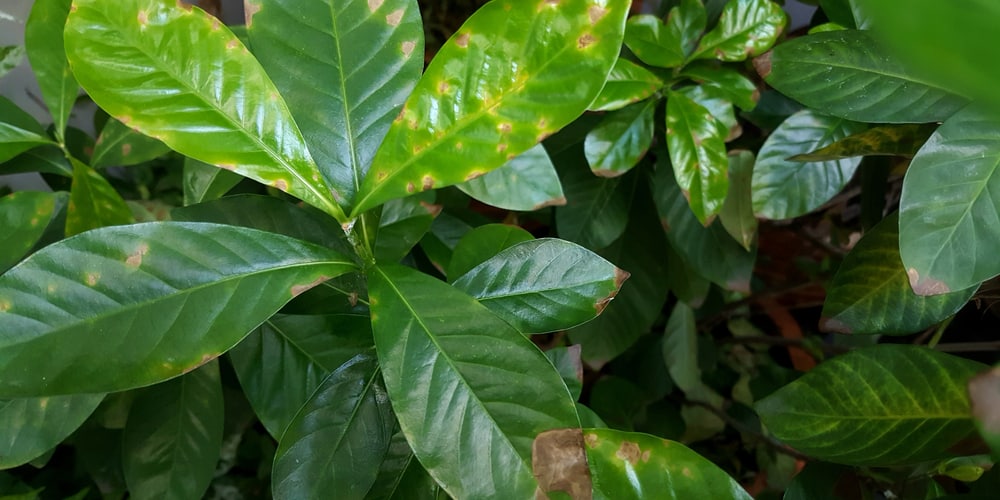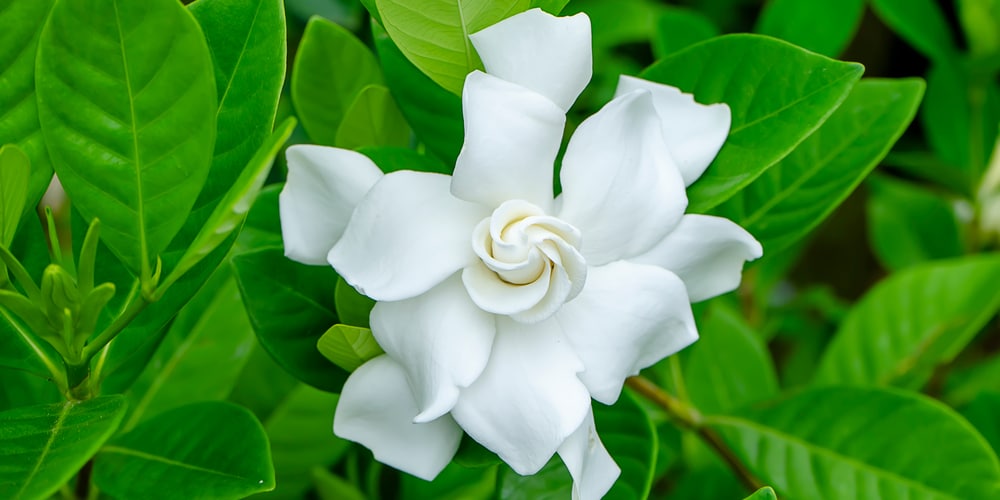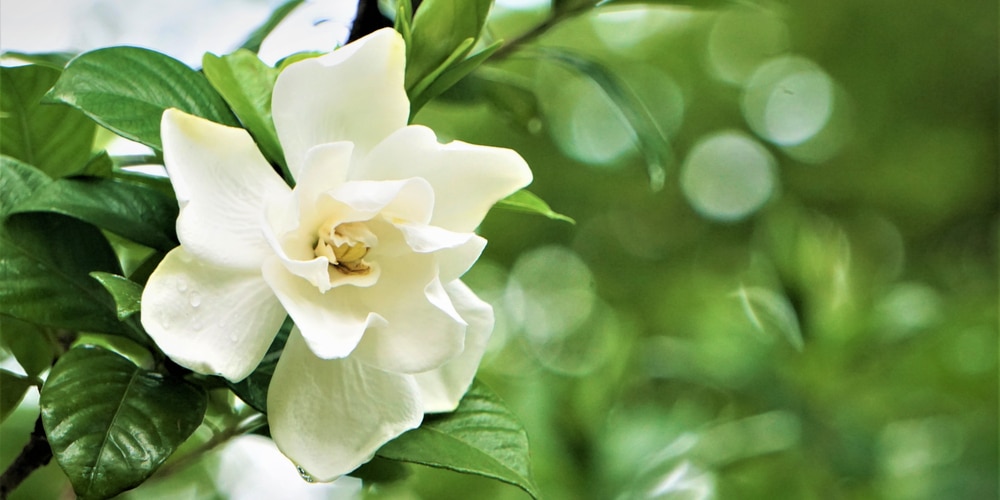The Gardenia Bush is an evergreen ornamental shrub with white, scented flowers.

| Botanical Name | Gardenia jasminoides |
| Common Name | Gardenia, Cape Jasmine |
| Plant Type | Perennial |
| Flower Color | Creamy white blooms |
| Size When Mature | 60 to 72 inches |
| Bloom Time | Spring or summer |
| Sun Requirements | Partial Sun, Partial Shade |
| USDA Hardiness Zones | 8 to 11 |
| Soil PH Range | 5.0 to 6.0 |
| Soil Type | Acidic, fertile |
| Water Needs | Medium |
| Native Area | Japan, Taiwan |
What you Need to Know About The Gardenia Bush
The Gardenia, aka Gardenia jasminoides, is a notorious flowering species with stunning foliage and breathtaking blooms. The white, creamy flowers are several inches in diameter and carry with them an unforgettably sweet scent.
If you’re willing to put up with very specific growing requirements of the Cape Jasmine, then you’ll find it a prized possession in the years to come. The Gardenia is slightly toxic to pets and will demand a lot from you. The characteristic white flowers may appear in spring or summer and last a month or two before turning to seed.
How to Care for the Gardenia Bush
Here’s everything you need to know about growing and caring for a thriving Gardenia
Light
The evergreen shrub can be grown as a houseplant indoors, or as a landscape highlight outdoors in the yard or garden. Care for the gardenia will be slightly different depending on where you want to put the plant.
Potted gardenia plants prefer bright indirect light in the hotter months, and partial sun on a sunny windowsill in spring and fall. Outside, you should put your gardenia bush in an area that gets a few hours of morning sun and shade in the afternoon. In zones 8 or 9 you can give the shrub a bit more sun but the Cape Jasmine still has to be protected from the afternoon sun.
Water and Soil Needs
Like azaleas and roses, the Gardenia Bush simply won’t grow to its full potential if you put them in alkaline soil. As a rule, you should prepare the soil in the yard or container so it’s within 5.0 to 6.0 soil pH. You can amend the medium with agricultural sulfur, ammonium sulfate, peat moss, or an acidic fertilizer.
The planting medium of a gardenia must also contain plenty of organic matter. Watering should be done regularly- keep the soil from drying out completely and your bush should do just fine. Indoors, you will need to increase humidity to keep the potted gardenia from drying out and the flower buds from dropping prematurely.
You can use a humidifier or add a tray of pebbles filled with clean water to improve humidity levels in your room. Take care not to overwater or underwater or you’ll see yellowed leaves and delayed flowering.
Temperature Requirements
Those interested in growing Gardenia Bush will have to account for their local climate and weather. The best zones for Cape Jasmine are in USDA zones 8 to 11, and the warmer the temperature, the better.
The evergreen shrub will want to stay in a tropical environment, although it needs to be protected from the afternoon sun and strong, cold winds. It’s ideal to add a layer of mulch to keep the moisture locked in and prevent weeds from growing near your gardenia bush.
The Gardenia plant grows best in daytime temperatures that are 65 to 70 degrees F and night temperatures that are 60 to 65 degrees F.
Fertilizer
The best fertilizer to use on a Gardenia Bush is an acidic formula in spring and summer.
As for organic options, you can feed your gardenia plant bone meal, fish emulsion, or blood meal once in spring and another in summer. Follow instructions as directed on the label, or lower the strength by half if you don’t want to over-fertilize your plant.
An acidic formula meant for roses and rhododendrons works best with gardenia. You can choose to get granular, liquid, or slow-release pellets depending on your preference. It’s worth noting that you should not fertilize in the fall season since your gardenia will enter dormancy in winter.
Common Diseases
The Gardenia Bush can be affected by a number of pests and diseases. You should watch out for common insects such as spider mites, scale, mealy bugs, and aphids and treat your plant immediately. The same goes when you see signs of stem canker, root rot, and powdery mildew.
It’s important that you inspect your gardenia shrub regularly for signs of an infestation. Check under the leaves for insects, as well as webs that a spider mite may leave behind. Yellow and brown spots on the leaves also serve as an indication that your plant is under attack.
When watering your gardenia bush it’s best to avoid getting the leaves wet to avoid stem canker and powdery mildew. In the same vein, do not allow too much water to collect in the soil, or else it will lead to root rot. Spray neem oil or insecticidal solution all over the foliage to ward off the pests, and prune away dead stems and leaves to keep your gardenia bush neat and happy.
Gardenia Bush Propagation
The easiest way to get more gardenia plants is to take cuttings and propagate them in a small pot.
Take four to six-inch cuttings of gardenia stems in spring and plant them in a moist medium made up of potting soil and perlite. It’s best to remove the lower leaves to expose the leaf nodes and dip the end in rooting hormone if you have it.
Keep the soil moist by spraying or lightly watering until roots have appeared. Also, put the container in a place that gets bright, indirect light. After about four to eight weeks you’ll start to see new growth. During this time, you can transplant it to its final home in a larger pot or outside your yard or garden.


